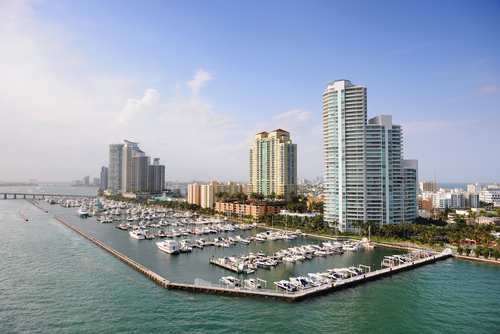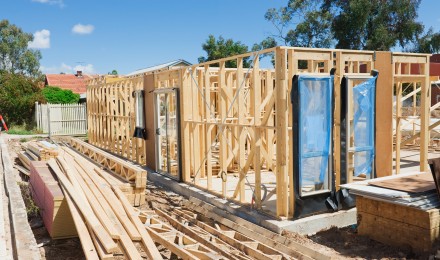As a metropolitan area, Miami has a larger reach than Phoenix or Las Vegas, with more than 5.5 million people. The 2010 U.S. C ensus Bureau sets the population of Miami and Miami-Dade County at more than 2,496,435 people. The median income for a family of four living in the Miami area has followed state and national trends as it has fallen to $40,145.
The Miami Real Estate Market
The Miami real estate market is entering its sixth year of a climate of declining home prices. The area has experienced one of the deepest declines in home values in the nation, about 50 percent of peak prices reached in 2006. Some analysts believe prices have started to stabilize. The, S&P/Case Shiller Housing Price Index showed a slight increase, of less than one percent, at the end of 2011, even as most of the other areas measured continue their decline.
Source: NY Times.com
The Federal Housing Finance Agency Housing Price Index Index shows that home prices in Miami-Dade rose 1.8 percent over the last two quarters of 2011. Miami-Dade reported a record number of home sales, with 24,949 transactions in 2011.
The Miami real estate market attracts international buyers from Asia, the European Union and Latin America, especially in the high-end real estate market. The MIAMI Association of REALTORS put February’s median sale price of a single-family home at $175,000, a 19 percent increase over February 2011. Condominium prices rose 40.4 percent over the same period, to $131,950. Miami’s home sales market has seen three straight months of gains.
In 2011, a significant portion of the transactions, 67 percent, consisted of foreclosed homes, REO properties and short sales. Through the first quarter of 2012, the rate of distressed transactions has fallen to 54 percent. In a typical real estate market, distressed home sales account for about seven percent of home sales in Miami. Sixty-five percent of all sales in February consisted of cash transactions. International buyers bought properties with cash 90 percent of the time.
Alto Research reports that homes average 191 days on market, as of April 8, 2012. The Miami rental market has gained much steam. Many renters come from the ranks of homeowners who lost their homes in foreclosure or by short sales. According to Zillow.com, the median rent price in Miami increased 8.1 percent on a yearly basis.
Local Economy
Miami’s location in southeast Florida makes it one of the major hubs for finance, commerce, culture, media, entertainment and international trade. Miami ranked seventh in the US in terms of commerce, finance, culture, fashion, entertainment, education and other segments of the economy.
In February 2011, Miami-Dade had an unemployment rate of 11.4 percent. In the last year, the area’s unemployment rate has declined to 9.7 percent in February 2012. Like many areas of the country, Miami, and the rest of Florida, depended heavily on the construction industry, which was in the midst of a boom before the recession hit. Since the peak, hiring levels reached in 2007, more than 80,000, of 207,000 jobs were lost, linked to the construction industry.
The housing depression prompted a global banking crisis that lingers. Miami-Dade now loses more jobs in finance each month than in construction. Those continued losses from the mortgage industry and insurance carriers are diluting the gains made by record hiring in the healthcare and hospitality industry.
As a metropolitan area, Miami has a larger reach than Phoenix or Las Vegas, with more than 5.5 million people. The 2010 U.S. C ensus Bureau sets the population of Miami and Miami-Dade County at more than 2,496,435 people. The median income for a family of four living in the Miami area has followed state and national trends as it has fallen to $40,145.
The Miami Real Estate Market
The Miami real estate market is entering its sixth year of a climate of declining home prices. The area has experienced one of the deepest declines in home values in the nation, about 50 percent of peak prices reached in 2006. Some analysts believe prices have started to stabilize. The, S&P/Case Shiller Housing Price Index showed a slight increase, of less than one percent, at the end of 2011, even as most of the other areas measured continue their decline.
Source: NY Times.com
The Federal Housing Finance Agency Housing Price Index Index shows that home prices in Miami-Dade rose 1.8 percent over the last two quarters of 2011. Miami-Dade reported a record number of home sales, with 24,949 transactions in 2011.
The Miami real estate market attracts international buyers from Asia, the European Union and Latin America, especially in the high-end real estate market. The MIAMI Association of REALTORS put February’s median sale price of a single-family home at $175,000, a 19 percent increase over February 2011. Condominium prices rose 40.4 percent over the same period, to $131,950. Miami’s home sales market has seen three straight months of gains.
In 2011, a significant portion of the transactions, 67 percent, consisted of foreclosed homes, REO properties and short sales. Through the first quarter of 2012, the rate of distressed transactions has fallen to 54 percent. In a typical real estate market, distressed home sales account for about seven percent of home sales in Miami. Sixty-five percent of all sales in February consisted of cash transactions. International buyers bought properties with cash 90 percent of the time.
Alto Research reports that homes average 191 days on market, as of April 8, 2012. The Miami rental market has gained much steam. Many renters come from the ranks of homeowners who lost their homes in foreclosure or by short sales. According to Zillow.com, the median rent price in Miami increased 8.1 percent on a yearly basis.
Local Economy
Miami’s location in southeast Florida makes it one of the major hubs for finance, commerce, culture, media, entertainment and international trade. Miami ranked seventh in the US in terms of commerce, finance, culture, fashion, entertainment, education and other segments of the economy.
In February 2011, Miami-Dade had an unemployment rate of 11.4 percent. In the last year, the area’s unemployment rate has declined to 9.7 percent in February 2012. Like many areas of the country, Miami, and the rest of Florida, depended heavily on the construction industry, which was in the midst of a boom before the recession hit. Since the peak, hiring levels reached in 2007, more than 80,000, of 207,000 jobs were lost, linked to the construction industry.
The housing depression prompted a global banking crisis that lingers. Miami-Dade now loses more jobs in finance each month than in construction. Those continued losses from the mortgage industry and insurance carriers are diluting the gains made by record hiring in the healthcare and hospitality industry.








